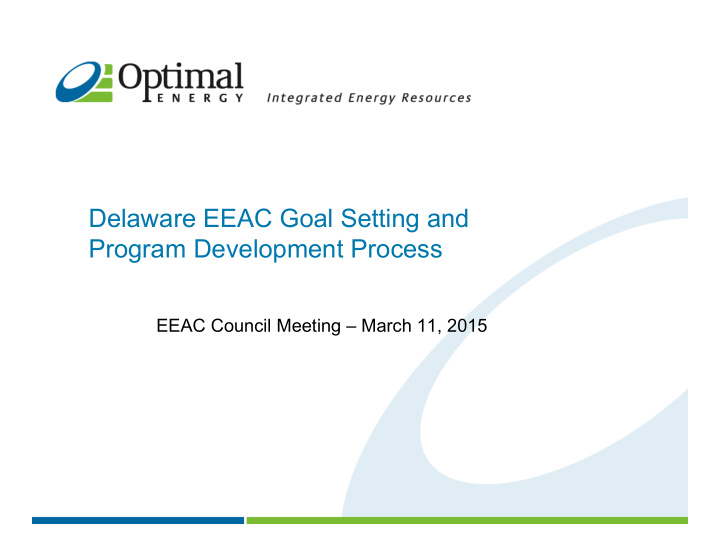



Delaware EEAC Goal Setting and Program Development Process EEAC Council Meeting – March 11, 2015
Electric Savings Trajectory Comparison Electric Program Savings 3.0% 2.5% 2.0% Percent of Retail Sales 1.5% 1.0% 0.5% 0.0% Baseline PY 1 PY2 PY3 PY4 PY5 PY6 Delaware Rhode Island Massachusetts 2
Gas Program Savings Trajectory Comparison Gas Program Savings 1.4% 1.2% 1.0% Percent of Retail Sales 0.8% 0.6% 0.4% 0.2% 0.0% Baseline PY 1 PY2 PY3 PY4 PY5 PY6 Delaware Rhode Island Massachusetts 3
Considerations in Setting Goals Initially framed and negotiated as relative savings – savings as percentage of retail sales Savings percentages translated to AEP-specific goals in physical energy units – kWh, therms Other goals may be desirable – Lifetime savings, rather than annual – Dollar benefits, the economic value of the savings – Net benefits, the economic value net of program costs Goals can be framed as individual annual goals and a three- year cumulative goal 4
Evolution of Potential Portfolio Program Mix At 0.4% of At 1.4% of retail load retail load 5
Program Candidates Received - Residential Market Residential Program Candidates Description segment New Green 4 Green Performance-based rebate program payable to Construction participating builders Home Energy Home Performance with Energy Existing home audit and direct install measures; Star rebates and financing for weatherization measures Services Home Performance w/ E* - Same as above with income eligibility requirement Moderate Income Existing home energy survey and direct install Quick Home Energy Checkup program, customer education Multiple Family Housing Incentive Prescriptive and custom rebate option for owners; Multifamily customer education for occupants Quick Home Energy Checkup – multifamily units Existing rental unit direct install program, customer education Residential Lighting and Appliance Rebates Point-of-purchase rebates (instant rebates and/or Products buydowns) Residential Appliance Recycling Rebates for pick-up/recycling of second Refrigerators/freezers Multiple Family Housing Incentive Prescriptive and custom rebate option for owners; Low Income customer education for occupants Services Community-Based Quick Energy Audit / Home Energy Advisor Existing home energy survey and direct install program, customer education – Low & moderate Smart Energy Neighborhood income neighborhoods Centers concept Central coordination of outreach and delivery of Low-income rebates/grant community-based energy services Supplement to efforts of entities delivering federal DOE WAP and LIHEAP Weatherization services Behavioral Behavioral savings program Customer bill insert messaging 6
Program Candidates Received - C&I Market C&I Program Candidates Description segment Prescriptive/Custom incentive Design support and incentives for new construction C&I Lost program and renovation in commercial, industrial and Opportunity institutional buildings Energy Assessments for Non- Subsidized energy audits providing recommended Small Business profits, business, and local ECMs, estimate cost/savings and payback periods Retrofit governments Energy audit and direct install for targeted small Small Business Energy Solutions businesses Energy Efficiency Investment Prescriptive/Custom incentive program also applies Fund Targeted audits, education, grants and financing for Faith Efficiencies Program – Audit houses of worship & Education Programs for Houses of Worship Prescriptive/Custom incentive Technical assistance and rebates for energy Large Business program upgrades Retrofit Energy Assessments for non- Subsidized energy audits providing recommended profits, business, and local ECMs, estimate cost/savings and payback periods governments Low/no cost optimization of operating Retro-commissioning program equipment/systems Energy Efficiency Investment Prescriptive/Custom incentive program Fund Dedicated outreach and service coordination support Account management services for for businesses large commercial and industrial customers 7
Summary and Next Steps Proposed savings goals are feasible and cost-effective Programs suggested by stakeholders and Consultants represent a comprehensive portfolio Several programs can be implemented in the near-term to begin progress towards goals Come to agreement on goals Select initial set of programs and delivery method Develop program budgets to achieve goals with selected programs 8
Mike Guerard and Eric Belliveau Optimal Energy, Inc. 10600 Route 116, Suite 3 Hinesburg, VT 05461 802-482-5600
Recommend
More recommend